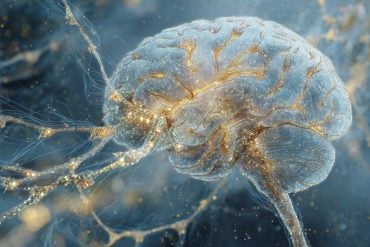Summary: Using transcranial magnetic stimulation, researchers were able to increase and decrease people’s enjoyment of music; and desire to listen to more.
Source: McGill University.
Enjoyment of music is considered a subjective experience; what one person finds gratifying, another may find irritating. Music theorists have long emphasized that although musical taste is relative, our enjoyment of music, be it classical or heavy metal, arises, among other aspects, from structural features of music, such as chord or rhythm patterns that generate anticipation and expectancy.
Now, researchers from the Montreal Neurological Institute and Hospital of McGill University have proven it is possible to increase or decrease our enjoyment of music, and our craving for more of it, by enhancement or disruption of certain brain circuits.
Previous studies using brain imaging found that listening to pleasurable music engages brain circuits involved in reward anticipation and surprise, known as the fronto-striatal circuits. However, nobody had ever tested whether these circuits are essential to musical reward, or if they can be manipulated, leading to changes in subjective and physiological measures of experienced musical pleasure.
In order to modulate the functioning of fronto-striatal circuits, the researchers from the lab of Robert Zatorre used a non-invasive brain stimulation technique, transcranial magnetic stimulation (TMS), which uses magnetic pulses to either stimulate or inhibit selected parts of the brain. In this case, the researchers applied TMS over the left dorsolateral prefrontal cortex (DLPFC). Brain imaging studies have shown that stimulation over this region modulates the functioning of fronto-striatal circuits, leading to the release of dopamine, a key neurotransmitter in reward processing.
In three separate sessions, the researchers applied either excitatory, inhibitory or no real TMS over the left DLPFC to healthy participants. After the stimulation, participants listened to their own favorite music as well as a music selection chosen by the researchers. While listening to the music, participants had to rate in real-time their enjoyment of the music, and the researchers also measured their psychophysiological responses. In addition, participants were offered the opportunity to purchase the music selected by the researchers, using real money, in order to measure their motivation to listen to the music again.

The researchers found that, compared to the control session, liking of music, psychophysiological measures of emotion and participants’ motivation to buy music were all enhanced by excitatory TMS, while all of these measures were decreased by inhibitory TMS.
“Their findings show that the functioning of fronto-striatal circuits is essential for our enjoyment of music. This indicates that the role of these circuits in learning and motivation may be indispensable for the experience of musical pleasure,” says Ernest Mas Herrero, a postdoctoral fellow and the study’s first author.
Mas Herrero is now using a combination of TMS and functional magnetic resonance imaging to determine which specific regions and circuits are responsible of the changes found in this study.
“Showing that pleasure and value of music can be changed by the application of TMS is not only an important–and remarkable–demonstration that the circuitry behind these complex responses is now becoming better understood, but it also has possible clinical applications,” says Robert Zatorre, a professor of neurology and neurosurgery and the study’s senior author. “Many psychological disorders such as addiction, obesity, and depression involve poor regulation of reward circuitry. Showing that this circuit can be manipulated so specifically in relation to music opens the door for many possible future applications in which the reward system may need to be up- or down-regulated.”
Funding: This study was published in the journal Nature Human Behaviour on Nov. 20, 2017. It was funded with support from the Natural Sciences and Engineering Research Council (NSERC), the Canadian Institutes of Health Research (CIHR), the Canada Foundation for Innovation (CFI) and the Jeanne Timmins Costello Fellowship.
Source: Shawn Hayward – McGill University
Publisher: Organized by NeuroscienceNews.com.
Image Source: NeuroscienceNews.com image is adapted from the McGill news release.
Original Research: Abstract for “Modulating musical reward sensitivity up and down with transcranial magnetic stimulation” by Ernest Mas-Herrero, Alain Dagher & Robert J. Zatorre in Nature Human Behavior. Published online November 20 2017 doi:10.1038/s41562-017-0241-z
[cbtabs][cbtab title=”MLA”]McGill University “Now You Like It, Now You Don’t: Brain Stimulation Changes Musical Enjoyment.” NeuroscienceNews. NeuroscienceNews, 20 November 2017.
<https://neurosciencenews.com/music-brain-stimulation-7986/>.[/cbtab][cbtab title=”APA”]McGill University (2017, November 20). Now You Like It, Now You Don’t: Brain Stimulation Changes Musical Enjoyment. NeuroscienceNews. Retrieved November 20, 2017 from https://neurosciencenews.com/music-brain-stimulation-7986/[/cbtab][cbtab title=”Chicago”]McGill University “Now You Like It, Now You Don’t: Brain Stimulation Changes Musical Enjoyment.” https://neurosciencenews.com/music-brain-stimulation-7986/ (accessed November 20, 2017).[/cbtab][/cbtabs]
Abstract
Modulating musical reward sensitivity up and down with transcranial magnetic stimulation
Humans have the unique capacity to experience pleasure from aesthetic stimuli, such as art and music. Recent neuroimaging findings with music have led to a model in which mesolimbic striatal circuits interact with cortical systems to generate expectancies leading to pleasure1,2. However, neuroimaging approaches are correlational. Here, we provide causal evidence for the model by combining transcranial magnetic stimulation over the left dorsolateral prefrontal cortex to directly modulate fronto-striatal function3 bidirectionally together with measures of pleasure and motivation during music listening. Our results show that perceived pleasure, psychophysiological measures of emotional arousal, and the monetary value assigned to music, are all significantly increased by exciting fronto-striatal pathways, whereas inhibition of this system leads to decreases in all of these variables compared with sham stimulation. These findings support the hypothesis that fronto-striatal function causally mediates both the affective responses and motivational aspects of music-induced reward, and provide insights into how aesthetic responses emerge in the human brain.
“Modulating musical reward sensitivity up and down with transcranial magnetic stimulation” by Ernest Mas-Herrero, Alain Dagher & Robert J. Zatorre in Nature Human Behavior. Published online November 20 2017 doi:10.1038/s41562-017-0241-z






